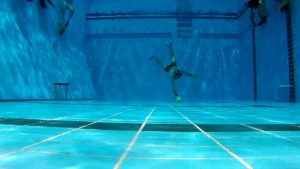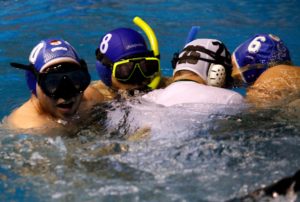If you’re yet to learn freestyle swimming or just don’t feel confident enough in your skills, you may want to read this guide. I’m no swim coach, but UWR does require some swimming skills, so my experience might be useful.
I think a lot of us cope with bad habits planted by the method of teaching kids lined up by the wall. They are not moving, and swimming is like biking, you have to keep moving. With hands on the wall, kids raise their heads high above the surface while kicking the water from the air with their knees. I suppose the reason behind this is that it allows one person to oversee many kids at the same time but it has definite drawbacks.
What you’ll need for practice:
1. googles or a mask
2. snorkel
3. fins
4. swimsuits
5. board
The more complex a movement is, the more it’s worth to take it apart to it’s elements in order to learn it. Googles and snorkel are required so that breathing, which coordinates the whole process, can be left to be practiced at the end, while fins are to aid proper body pose and technique. The board allows the movement of legs and arms to be practiced separately, and I’ve noted swimsuits too, because too often you see newbies wearing beach shorts at the pool which act like flimsy breaking chutes in the water.
And of course never practice alone.
The freestyle stroke was introduced by Sir John Arthur Trudgen in 1873 in London, who acquired the knowledge of this skill from inhabitants of South-America. Prior to that, people swam with breast-stroke, and for decades the frog kicks were still used combined with the freestyle stroke. At the first modern Olympics in 1896, Alfréd Hajós won gold medal with the freestyle stroke and scissor kicks. The name freestyle refers to the fact that any kind of style is allowed, except for the dolphin. Maybe if FINA would lift this limitation, it would bring such a revolution in swimming like the introduction of the freestyle stroke 250 years ago.
First thing you need to do is to get used to the googles or the mask if it’s your first time wearing one. Pick one which is comfortable and allows as much vision as possible. Dive by the wall and breathe out as you surface, repeat till you feel at ease in the water. Next step is getting used to the snorkel, the goal is again to breath out as you surface, blowing the water out from the tube. It’s easy as long as it’s the only thing you need to do, but it needs to be instinctive later as you take on actual swimming.
Practice gliding! Kick off from the wall to see how far you can glide in the water. You should be in a fully extended body position, your arms reaching out far ahead with your palms crossed and your feet arching, while your head looking straight at the bottom. You’d want to shape an arrow, long and narrow. You can check your pose in a mirror, there are always arms to be hidden behind the ears. This is also the base of the dolphin-kick. If you start using the snorkel early on, you’ll find it easier to watch the proper execution of any drill.
Then comes the kick. The fins come handy making the movement slower and more thrustful, which makes errors easier to spot, you’re going to feel what is to be corrected. When doing the scissor kicks, keep the fully extended position with your board in front, and try not to work from your knees, use your thighs and hips instead. Arch your feet, which should not be raised above the surface, and the arch of their up and down movement should stay behind your body’s “shadow”. Too huge of an arch brakes the momentum, although not as much as a huge kick on the surface of the water from the knees. The goal is a continuous, flow-like motion. You can try using just the board without the fins after a while.
Now about the stroke. There are plenty of descriptions of what’s considered ideal. My experience is that trying to reach further, entering the water with the least resistance and pulling from as deep as possible it the most efficient and fastest way I can swim. It’s worth to take some time to observe how you hold your palm when you penetrate the water. A lot depends on your body composition and personal style, but a lot like in finswimming, I think pace is less important than how long and streamlined your movement is. Long distance swimmers tend to glide between strokes. When swimming with strokes only, keep your feet straight and extended right below the surface.
Coordinating the arms and legs wont be such a challenge at this point. Notice that the frequency of the strokes effect the ideal rhythm of the kicks too, as the main purpose of the kicks is to balance the alternating strokes of the arms. Needles to say that the use of the snorkels help a lot to focus on this without having to pay attention to breathing.
My advice is that early on try not to think of practice as a workout, but a constant call to improve your technique. Keep doing drills till you execute them flawlessly. Make it a habit to push your pace exactly to that limit where your movement starts falling apart, take a break and reflect on when and where you fell out of rhythm and repeat. This method helps you find the most effective pace you can keep, similar to the ones long distance runners keep to run out of the world.
Why are the fins needed? The increase in velocity is proportional to the increase in resistance squared. You gain speed without increasing the pace of your legs, keeping the movement forceful and controlled, while increasing the role of proper body position and rhythm. No wonder they call finswimming the F1 of swimming…
With all this done, you can make practices more entertaining. For example, if you return to the glide, you can experiment how far one huge whiplashing kick or a pair of scissors take you. You can do freestyle in a constant roll over your back in one direction or another, just try not to puke at the end. It sounds weird but it’s fun plus the more you experiment at practice, the safer you’ll be in the water.
At this point you may leave the snorkel and I promise your breathing will be instinctive. Just don’t turn your head. There is no clear advice on this, I’d say your turn should roll on your shoulders but it should also turn your whole body to a certain extent. It may not be the fastest style, but it’s definitely the most effective, pretty common amongst triathletes and long distance swimmers.So don’t drop your shoulders, but again, reach as far as you can, and as you turn, your head is still straight, but with your body’s twist, it’s halfway out of the water, right atop your extended arm. It’s a convenient style for which breathing at every 3rd stroke is more than enough and you also have plenty of time to breathe out. I suggest doing that through your nose. Also, avoid breathing on just one side, it distorts the symmetry of your swim over time and provides no advantage.
Laid out like this, it’s not that difficult anymore, right?
Keep a nice pace and if it’s going great, increase intensity till the rhythm falls apart and try to stay around this limit.
Your choice of fins matter. Scuba fins or freediving fins wont do, best if you pick one designed for finswimming. ( Najade, Muréna )
I’ve found this method to be the fastest to improve swimming skills.
Still nothing beats having a coach oversee your work. If your goal is to be the fastest swimmer, I’d recommend the trainings of the diving club Amphora, lead by Viktória Czech. And if you want to enjoy your skills, dive into underwater rugby with The Current UWR!



